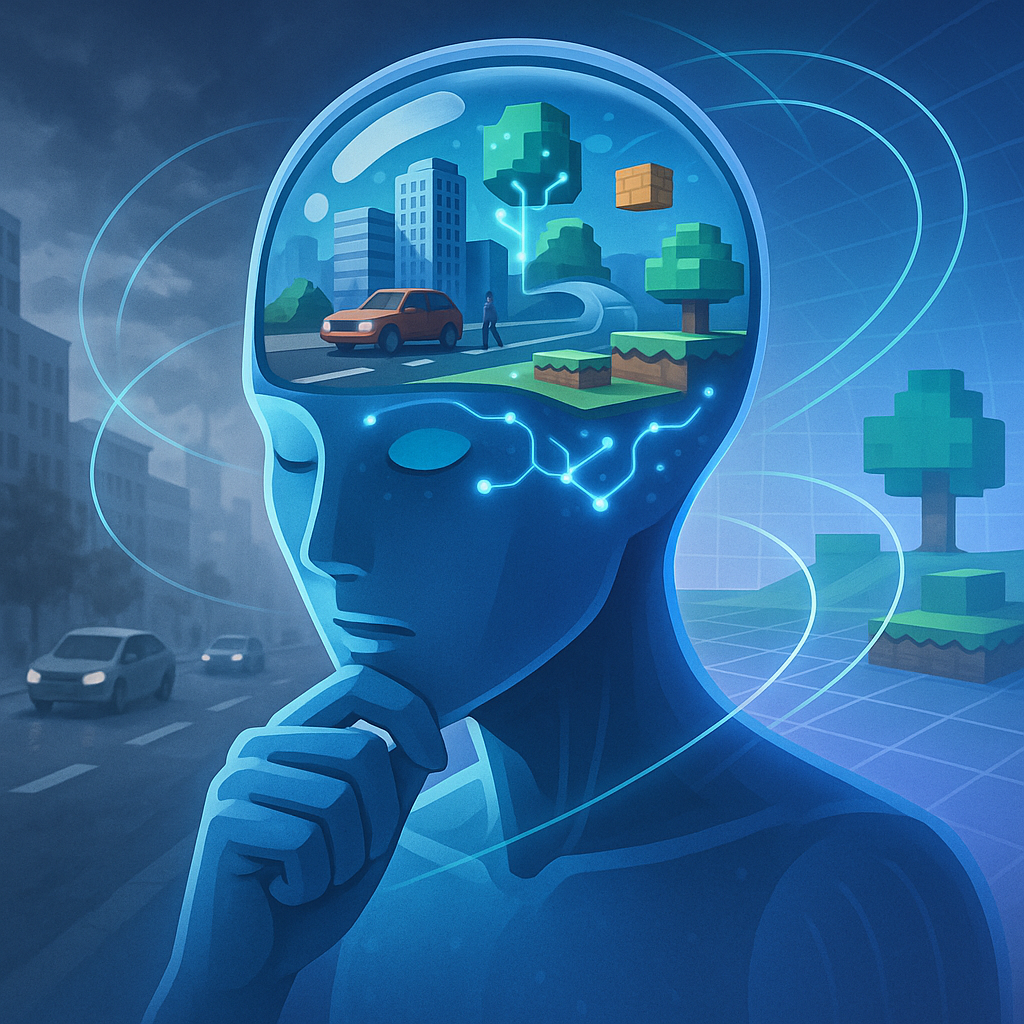Artificial intelligence has come a long way—think voice assistants, recommendation algorithms, and self-driving cars. Most of these breakthroughs are thanks to deep learning, a powerful technique that helps machines recognise patterns in mountains of data. However, as impressive as deep learning can be, it still has its limits, especially when AI is introduced to the complexities of the real world. That’s where something called world models enters the picture.
What if we could teach machines not just to react, but to imagine? To think ahead? World models aim to do exactly that, and they’re shaping up to be a game-changer in how AI learns, plans, and acts.
What Are World Models and Why Do They Matter?
Imagine you’re about to cross a busy street. You pause, look both ways, and quickly picture what might happen if a car speeds around the corner. That little mental simulation helps you decide whether to proceed or wait. This is, in essence, what world models allow AI to do—picture possible outcomes before taking action.
Instead of reacting purely based on past data, an AI agent with a world model builds an internal simulation of its environment. It can then “dream” or run trials in its mind to test different strategies, much like you visualise that crosswalk scenario.
How Are World Models Different from Deep Learning?
- Deep Learning: Excellent for identifying patterns and making predictions from past data. It’s like muscle memory without much reasoning.
- World Models: Give AI the ability to mentally simulate future events, plan ahead, and adapt when the environment changes—much closer to how humans think.
This difference matters because real-world environments—unlike static datasets—are messy, unpredictable, and often full of surprises. And AI needs more than pattern recognition to handle that.
Inspired by the Human Mind
So, where did the idea of world models come from? The inspiration is surprisingly human!
Picture a chess player thinking several moves ahead. They don’t just react to what’s in front of them—they run simulations in their head to figure out the best course of action. AI researchers wanted to give machines a similar power: the ability to rehearse outcomes before committing to a decision.
These internal simulations help AI agents develop foresight and flexibility. In fact, many are calling this approach the next natural step in the evolution of machine intelligence.
Where Are World Models Used?
At first, world models found their footing in video games and simulated environments. And for good reason—games are structured, visual, and perfect for testing AI’s ability to predict outcomes.
What Real Impact Have World Models Made?
- Atari Games: AI agents with world models learned to dominate classic games with fewer steps and less trial-and-error than traditional systems. They could practice in their “minds” before actually playing.
- Robotic Navigation: Robots trained with world models performed better in tasks like walking or navigating unknown terrain, because they could simulate various choices and avoid dead ends without crashing in the real world.
It’s not just about better scores or smoother walks. These AI agents are also safer and require far less data to learn—a big advantage when testing on expensive or risky hardware.
Challenges: What’s Holding World Models Back?
Despite the promise, building good world models isn’t easy. Let’s look at why.
- Realism: Creating internal worlds that truly match real-life scenarios is tough. Even small mismatches between the model and reality can lead to poor decisions.
- Scalability: Complex simulations need a lot of computing power and smart algorithms to stay efficient.
- Generalisation: Many world models work well in one environment but struggle to adapt to others. Making them flexible is an ongoing challenge.
What’s Being Done to Overcome These Issues?
- Researchers are designing more refined ways for AI to learn accurate and transferable representations of the world.
- Hybrid models are emerging, combining the best of deep learning and world modeling—for instance, using deep learning to recognize patterns but adding simulated planning for better decisions.
It’s a bit like giving AI both memory and imagination—each backing the other up.
Recent Breakthroughs in World Model Research
So, who’s leading the charge in this exciting space? Quite a few tech giants and AI research companies have made recent waves.
- OpenAI: Their agents are trained with world model principles to excel at multiplayer environments where strategy and quick adaptation matter most.
- Google DeepMind: The “Dreamer” algorithm is a huge step forward. It teaches agents to think ahead using compact, predictive models—and it works wonders in both digital games and real-world robotics.
- Autonomous Driving: Self-driving car companies are using world models to let vehicles imagine various traffic situations, predict pedestrian behavior, and avoid potential accidents—before they happen.
- Benchmarking Efforts: To help measure how well these systems perform, researchers are building tougher, more realistic tests to evaluate their adaptability.
Where Is This All Headed?
The future of AI looks more dynamic, thoughtful, and—dare we say—human. World models are pushing machines toward reasoning, not just reacting.
- Higher Reliability: With the ability to think ahead, AI agents make more consistent and safer decisions in real-world environments.
- Wider Applications: From gaming and logistics to healthcare and creative tools, world models unlock smarter planning across industries.
- Persistent Challenges: We’re still tackling ethical concerns, energy efficiency, and how to keep simulations aligned with reality. But the progress is promising.
Which industries could benefit most from this shift? Practically all of them. Anywhere AI needs to navigate uncertainty—from a robot wandering a warehouse to a digital assistant scheduling your chaotic day—world models could make the difference.
Conclusion
World models are helping AI take a big leap—from simply spotting patterns to planning with purpose. By letting machines simulate possible futures, we’re making them smarter, safer, and better at solving real-world problems.
While deep learning laid the foundation, world models are helping AI grow beyond its limits—to imagine, adapt, and even dream. And just like us, a little imagination might be the key to facing the unpredictable world ahead.
Want to stay updated on the latest in AI and robotics? Subscribe to our newsletter for fresh insights, expert interviews, and cutting-edge research highlights!




